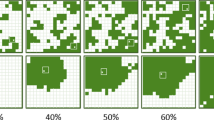Abstract
Habitat area and fragmentation are confounded in many ecological studies investigating fragmentation effects. We thus devised an innovative experiment founded on fractal neutral landscape models to disentangle the relative effects of habitat area and fragmentation on arthropod community patterns in red clover (Trifolium pratense). The conventional approach in experimental fragmentation studies is to adjust patch size and isolation to create different landscape patterns. We instead use fractal distributions to adjust the overall amount and fragmentation of habitat independently at the scale of the entire landscape, producing different patch properties. Although habitat area ultimately had a greater effect on arthropod abundance and diversity in this system, we found that fragmentation had a significant effect in clover landscapes with ≤40 % habitat. Landscapes at these lower habitat levels were dominated by edge cells, which had fewer arthropods and lower richness than interior cells. Fragmentation per se did not have a direct effect on local-scale diversity, however, as demonstrated by the lack of a broader landscape effect (in terms of total habitat area and fragmentation) on arthropods within habitat cells. Fragmentation—through the creation of edge habitat—thus had a strong indirect effect on morphospecies richness and abundance at the local scale. Although it has been suggested that fragmentation should be important at low habitat levels (≤20–30 %), we show that fragmentation per se is significant only at intermediate (40 %) levels of habitat, where edge effects were neither too great (as at lower levels of habitat) nor too weak (as at higher levels of habitat).





Similar content being viewed by others
References
Andrén H (1994) Effects of habitat fragmentation on birds and mammals in landscapes with different proportions of suitable habitat: a review. Oikos 71:355–366
Bolger DT, Suarez AV, Crooks KR, Morrison SA, Case TJ (2000) Arthropods in urban habitat fragments in southern California: area, age and edge effects. Ecol Appl 10:1230–1248
Debinski DM, Holt RD (2000) A survey and overview of habitat fragmentation experiments. Conserv Biol 14:342–355
Ewers RM, Didham RK (2006) Confounding factors in the detection of species responses to habitat fragmentation. Biol Rev 81:117–142
Ewers RM, Thorpe S, Didham RK (2007) Synergistic interactions between edge and area effects in a heavily fragmented landscape. Ecology 88:96–106
Fagan WF, Cantrell RS, Cosner C (1999) How habitat edges change species interactions. Am Nat 153:165–182
Fahrig L (1997) Relative effects of habitat loss and fragmentation on population extinction. J Wildl Manag 61:603–610
Fahrig L (2003) Effects of habitat fragmentation on biodiversity. Annu Rev Ecol Syst 34:487–515
Fletcher RJ Jr, Ries L, Battin J, Chalfoun AD (2007) The role of habitat area and edge in fragmented landscapes: definitively distinct or inevitably intertwined? Can J Zool 85:1017–1030
Gardner RH, Milne BT, Turner MG, O’Neill RV (1987) Neutral models for the analysis of broad-scale landscape pattern. Landsc Ecol 1:19–28
Henderson PA, Seaby RMH (2007) Community Analysis Package 4.0. Pisces Conservation, Lymington
Laurance WF (2002) Hyperdynamism in fragmented habitats. J Veg Sci 13:595–602
Lawton JH (1999) Are there general laws in ecology? Oikos 84:177–192
Magurran AE (1988) Ecological diversity and its measurement. Princeton University Press, New Jersey
McGarigal K, Cushman SA (2002) Comparative evaluation of experimental approaches to the study of habitat fragmentation effects. Ecol Appl 12:335–345
Öckinger E, Schweiger O, Crist TO, Debinski DM, Krauss J, Kuussaari M, Petersen JD, Pöyry J, Settele J, Summerville KS, Bommarco R (2010) Life-history traits predict species responses to habitat area and isolation: a cross-continental synthesis. Ecol Lett 13:969–979
Olson D, Andow D (2008) Patch edges and insect populations. Oecologia 155:549–558
Prugh LR, Hodges KE, Sinclair ARE, Breshares JS (2008) Effect of habitat area and isolation on fragmented animal populations. Proc Natl Acad Sci USA 105:20770–20775
Seaby RM, Henderson PA (2006) Species diversity and richness, Version 4. Pisces Conservation, Lymington
Thies C, Tscharntke T (1999) Landscape structure and biological control in agroecosystems. Science 285:893–895
Tscharntke T, Steffan-Dewenter I, Kruess A, Thies C (2002a) Characteristics of insect populations on habitat fragments: a mini-review. Ecol Res 17:229–239
Tscharntke T, Steffan-Dewenter I, Kruess A, Thies C (2002b) Contribution of small habitat fragments to conservation of insect communities of grassland-cropland landscapes. Ecol Appl 12:354–363
van Nouhuys S (2005) Effects of habitat fragmentation at different trophic levels in insect communities. Ann Zool Fenn 42:433–447
With KA (1997) The application of neutral landscape models in conservation biology. Conserv Biol 11:1069–1080
With KA, King AW (1997) The use and misuse of neutral landscape models in ecology. Oikos 79:219–229
With KA, King AW (1999a) Extinction thresholds for species in fractal landscapes. Conserv Biol 13:314–326
With KA, King AW (1999b) Dispersal success in fractal landscapes: a consequence of lacunarity thresholds. Landsc Ecol 14:73–82
With KA, Pavuk DM (2011) Habitat area trumps fragmentation effects on arthropods in an experimental landscape system. Landsc Ecol 26:1035–1048
With KA, Pavuk DM, Worchuck JL, Oates RK, Fisher JL (2002) Threshold effects of landscape structure on biological control in agroecosystems. Ecol Appl 12:52–65
Acknowledgments
This research was supported by a grant from the National Science Foundation (DEB-9610159). We gratefully acknowledge the assistance provided by H. Beecheler, S. Cadaret, J. Brubaker, and S. Grimes in helping to establish and maintain the clover plots, and R. Kappel for help with microarthropod sampling. We also thank Dr. Leigh Murray (KSU Department of Statistics) for advice on statistical design and analysis.
Author information
Authors and Affiliations
Corresponding author
Additional information
Communicated by Diethart Matthies.
Electronic supplementary material
Below is the link to the electronic supplementary material.
Rights and permissions
About this article
Cite this article
With, K.A., Pavuk, D.M. Direct versus indirect effects of habitat fragmentation on community patterns in experimental landscapes. Oecologia 170, 517–528 (2012). https://doi.org/10.1007/s00442-012-2325-9
Received:
Accepted:
Published:
Issue Date:
DOI: https://doi.org/10.1007/s00442-012-2325-9




